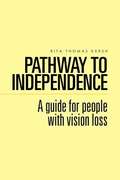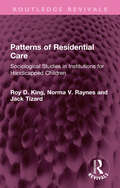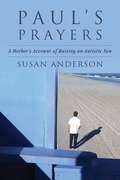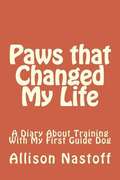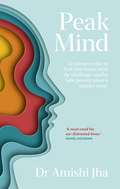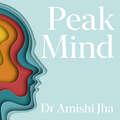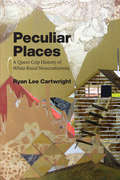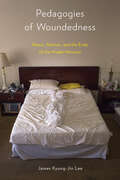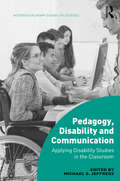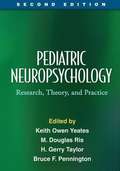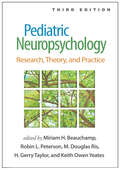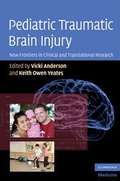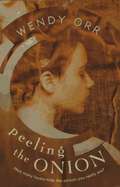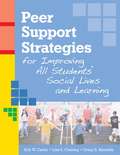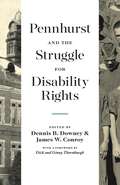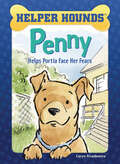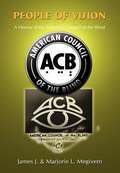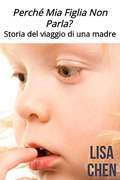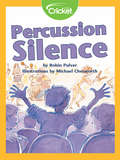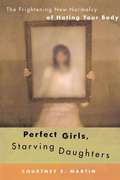- Table View
- List View
Pathway to Independence: A Guide for People with Vision Loss
by Rita Thomas KershMany helpful hints for people with severe vision loss or blindness.
Patterns of Residential Care: Sociological Studies in Institutions for Handicapped Children (Routledge Revivals)
by Jack Tizard Roy D. King Norma V. RaynesOriginally published in 1971, this title describes a series of studies dealing with the upbringing of children in residential institutions. Most work has been carried out in institutions for children with learning disabilities, although units caring for able but deprived children and children with physical disabilities have also been examined. The investigations have been concerned with the detailed nature of different institutional environments – that is, the routine patterns of daily life in hospital wards, hostels and cottages of children’s homes – rather than with the effects of specific child-rearing practices upon the intellectual, emotional and social development of the children. The more precise delineation of ‘the environment’ is an essential step towards the evaluation of residential services and the interpretation of their effects upon those who use them, yet this is an area which had received little systematic attention from social scientists at the time. This book is a re-issue originally published in 1971. The language used is a reflection of its era and no offence is meant by the Publishers to any reader by this re-publication.
Paul's Prayers: A Mother's Account of Raising an Autistic Son
by Susan AndersonRecipient of the Catholic Writers Guild 2018 Seal of Approval“A journey of compassion, frustration, and triumph . . . Anderson’s love for her son marks this beautiful portrait of family and faith.” —Publishers WeeklyPaul's Prayers is the story of a moderately autistic young man navigating life with a spiritual intelligence that runs further than most people can walk. Written by Paul's mother, this insightful memoir gives readers a unique look at the challenges and joys of raising her autistic son in a large Catholic family. The first of six children, Paul's early years were an exciting and confusing time for his parents. At the time, very little information on autism and its early signs was available, and the fact that the disorder is a spectrum ranging from mild to severe was not widely known. Unpredictable outbursts and sensitivities to light and schedule disruptions lead Paul's parents to refer to his condition as "The Marauder." The Marauder sweeps over the hospital nursery as the fluorescent lights blind Paul's eyes. The Marauder throws his black cape over the Christmas holidays, stealing four-year-old Paul's speech for three long days. In school, The Marauder keeps other students at bay, leaving Paul isolated and alone. Finally a developmental assessment gives some clarity to the exhausted family: Paul is on the autism spectrum, and they will all have to adjust their perspectives. Small victories emerge as Paul begins to reach developmental milestones in creative ways. Six years of piano lessons lead to a dramatic improvement in reading skills. A jaunt through the mountains with his father introduces Paul to his talent for running; with his brothers, he joins the high school cross country running team, which goes on to win the state championship. After high school, Paul works for the family business and attends college. Throughout this intimate memoir, every day is a challenge to be met with creative thinking, patience, and faith. Paul finds comfort in contemplative prayer and the support of his family when the world around him becomes too chaotic. As her son grows up, Susan Anderson learns how to cope with autism and embrace the importance of faith in the things unseen. Her family's experience is a beacon of light for those who find themselves on a similar path.
Paws That Changed My Life: A Diary About Training With My First Guide Dog
by Allison NastoffThis book is a diary, adapted from my blog on LiveJournal, in which I chronicle the preparation and training for my first service dog through an in-home training program.
Peaceful Mind: Using Mindfulness & Cognitive Behavioral Psychology to Overcome Depression
by John R. Mcquaid Paula E. CarmonaThe use of mindfulness practice and cognitive behavior therapy in treating depression.
Peak Mind: Find Your Focus, Own Your Attention, Invest 12 Minutes a Day
by Amishi Jha'This book can catapult you into living fully the life that is yours to live while you have the chance' Jon Kabat-Zinn'A must-read for our distracted times' Dan Goleman'A must-have guide to experiencing every moment of our lives' Goldie Hawn'A treasure trove of insights and exercises to enrich our lives' Dan SiegelStop for a moment. Are you here right now?Is your focus on the words in front of you? Or is it roaming elsewhere, to the past or future, to a worry, to your to-do list, or to your phone?The good news: There's nothing wrong with you - your brain isn't broken. The human brain was built to be distractible.The even better news: You can train your brain to pay attention more effectively.Acclaimed neuroscientist Dr Amishi Jha has dedicated her life's work to understanding the science of attention at every level - from brain imaging studies in the lab to field testing soldiers, firefighters and athletes. Her mission has been to scientifically determine how we can harness the full power of our attention to better meet all that life demands. In Peak Mind, Dr Jha expertly guides readers through fascinating research, debunking common assumptions about focus and attention, and offers remarkably easy-to-adapt flexible twelve minute-a-day exercises to lift the mental fog, declutter the mind, and strengthen focus so that you can experience more of your life.
Peak Mind: Find Your Focus, Own Your Attention, Invest 12 Minutes a Day
by Amishi Jha'This book can catapult you into living fully the life that is yours to live while you have the chance' Jon Kabat-Zinn'A must-read for our distracted times' Dan Goleman'A must-have guide to experiencing every moment of our lives' Goldie Hawn'A treasure trove of insights and exercises to enrich our lives' Dan SiegelStop for a moment. Are you here right now?Is your focus on the words in front of you? Or is it roaming elsewhere, to the past or future, to a worry, to your to-do list, or to your phone?The good news: There's nothing wrong with you - your brain isn't broken. The human brain was built to be distractible.The even better news: You can train your brain to pay attention more effectively.Acclaimed neuroscientist Dr Amishi Jha has dedicated her life's work to understanding the science of attention at every level - from brain imaging studies in the lab to field testing soldiers, firefighters and athletes. Her mission has been to scientifically determine how we can harness the full power of our attention to better meet all that life demands. In Peak Mind, Dr Jha expertly guides readers through fascinating research, debunking common assumptions about focus and attention, and offers remarkably easy-to-adapt flexible twelve minute-a-day exercises to lift the mental fog, declutter the mind, and strengthen focus so that you can experience more of your life.
Peculiar Places: A Queer Crip History of White Rural Nonconformity
by Ryan Lee CartwrightThe queer recluse, the shambling farmer, the clannish hill folk—white rural populations have long disturbed the American imagination, alternately revered as moral, healthy, and hardworking, and feared as antisocial or socially uncouth. In Peculiar Places, Ryan Lee Cartwright examines the deep archive of these contrary formations, mapping racialized queer and disability histories of white social nonconformity across the rural twentieth-century United States. Sensationalized accounts of white rural communities’ aberrant sexualities, racial intermingling, gender transgressions, and anomalous bodies and minds, which proliferated from the turn of the century, created a national view of the perversity of white rural poverty for the American public. Cartwright contends that these accounts, extracted and estranged from their own ambivalent forum of community gossip, must be read in kind: through a racialized, materialist queercrip optic of the deeply familiar and mundane. Taking in popular science, documentary photography, news media, documentaries, and horror films, Peculiar Places orients itself at the intersections of disability studies, queer studies, and gender studies to illuminate a racialized landscape both profoundly ordinary and familiar.
Peculiar Places: A Queer Crip History of White Rural Nonconformity
by Ryan Lee CartwrightThe queer recluse, the shambling farmer, the clannish hill folk—white rural populations have long disturbed the American imagination, alternately revered as moral, healthy, and hardworking, and feared as antisocial or socially uncouth. In Peculiar Places, Ryan Lee Cartwright examines the deep archive of these contrary formations, mapping racialized queer and disability histories of white social nonconformity across the rural twentieth-century United States. Sensationalized accounts of white rural communities’ aberrant sexualities, racial intermingling, gender transgressions, and anomalous bodies and minds, which proliferated from the turn of the century, created a national view of the perversity of white rural poverty for the American public. Cartwright contends that these accounts, extracted and estranged from their own ambivalent forum of community gossip, must be read in kind: through a racialized, materialist queercrip optic of the deeply familiar and mundane. Taking in popular science, documentary photography, news media, documentaries, and horror films, Peculiar Places orients itself at the intersections of disability studies, queer studies, and gender studies to illuminate a racialized landscape both profoundly ordinary and familiar.
Peculiar Places: A Queer Crip History of White Rural Nonconformity
by Ryan Lee CartwrightThe queer recluse, the shambling farmer, the clannish hill folk—white rural populations have long disturbed the American imagination, alternately revered as moral, healthy, and hardworking, and feared as antisocial or socially uncouth. In Peculiar Places, Ryan Lee Cartwright examines the deep archive of these contrary formations, mapping racialized queer and disability histories of white social nonconformity across the rural twentieth-century United States. Sensationalized accounts of white rural communities’ aberrant sexualities, racial intermingling, gender transgressions, and anomalous bodies and minds, which proliferated from the turn of the century, created a national view of the perversity of white rural poverty for the American public. Cartwright contends that these accounts, extracted and estranged from their own ambivalent forum of community gossip, must be read in kind: through a racialized, materialist queercrip optic of the deeply familiar and mundane. Taking in popular science, documentary photography, news media, documentaries, and horror films, Peculiar Places orients itself at the intersections of disability studies, queer studies, and gender studies to illuminate a racialized landscape both profoundly ordinary and familiar.
Pedagogies of Woundedness: Illness, Memoir, and the Ends of the Model Minority (D/C: Dis/color)
by James Kyung-Jin LeeThe pressures Asian Americans feel to be socially and economically exceptional include an unspoken mandate to always be healthy. Nowhere is this more evident than in the expectation for Asian Americans to enter the field of medicine, principally as providers of care rather than those who require care. Pedagogies of Woundedness explores what happens when those considered model minorities critically engage with illness and medicine whether as patients or physicians. James Kyung-Jin Lee considers how popular culture often positions Asian Americans as medical authorities and what that racial characterization means. Addressing the recent trend of writing about sickness, disability, and death, Lee shows how this investment in Asian American health via the model minority is itself a response to older racial forms that characterize Asian American bodies as diseased. Moreover, he pays attention to what happens when academics get sick and how illness becomes both methodology and an archive for scholars. Pedagogies of Woundedness also explores the limits of biomedical “care,” the rise of physician chaplaincy, and the impact of COVID. Throughout his book and these case studies, Lee shows the social, ethical, and political consequences of these common (mis)conceptions that often define Asian Americans in regard to health and illness.
Pedagogy, Disability and Communication: Applying Disability Studies in the Classroom (Interdisciplinary Disability Studies)
by Michael JeffressResearch has long substantiated the fact that living with a disability creates significant and complex challenges to identity negotiation, the practice of communication, and the development of interpersonal relationships. Furthermore, individuals without disabilities often lack the knowledge and tools to experience self-efficacy in communicating with their differently-abled peers. So how do these challenges translate to the incorporation of disability studies in a classroom context and the need to foster an inclusive environment for differently-abled students? <p><p> Bringing together a range of perspectives from communication and disability studies scholars, this collection provides a theoretical foundation along with practical solutions for the inclusion of disability studies within the everyday curriculum. It examines a variety of aspects of communication studies including interpersonal, intercultural, health, political and business communication as well as ethics, gender and public speaking, offering case study examples and pedagogical strategies as to the best way to approach the subject of disability in education. <p> It will be of interest to students, researchers and educators in communication and disability studies as well as scholars of sociology and social policy, gender studies, public health and pedagogy. It will also appeal to anyone who has wondered how to bring about a greater degree of inclusion and ethics within the classroom.
Pediatric Neuropsychology, Second Edition
by Keith Yeates M. RisThe most comprehensive, authoritative reference of its kind, this acclaimed work examines a wide range of acquired, congenital, and developmental brain disorders and their impact on children\u2019s neuropsychological functioning. Leading experts present state-of-the-art knowledge about how each condition affects the developing brain; the nature and severity of associated cognitive, behavioral, and psychosocial impairments; and effective approaches to clinical evaluation and treatment planning. New to This Edition Reflects significant scientific advances. An additional coeditor, Bruce F. Pennington. Chapters on math, reading, and language disabilities; attention-deficit/hyperactivity disorder; autism; and intellectual disabilities. Medical disorders not covered in prior edition acute disseminated encephalomyelitis and multiple sclerosis; tuberous sclerosis; childhood stroke; and fetal alcohol syndrome. A chapter on evidence-based neuropsychological interventions.
Pediatric Neuropsychology, Third Edition: Research, Theory, and Practice
by Miriam H. Beauchamp, Robin L. Peterson, M. Douglas Ris, H. Gerry Taylor and Keith Owen YeatesRecognized as the definitive reference and text on the relationship between brain health and behavior in children and adolescents, this volume is now in a third edition with 75% new material, including major updates throughout and numerous new chapters. Leading experts provide a neuropsychological perspective on medical, neurological, genetic, and developmental disorders that are frequently seen in clinical practice. The volume examines the impact of each condition on the developing brain; explores associated cognitive, behavioral, and psychosocial impairments; and shows how the science translates into achieving better outcomes for children. New to This Edition *Reflects 12 years of significant research advances and the expanding role of pediatric neuropsychologists; increased attention to evidence-based intervention throughout. *Chapters on additional medical and neurodevelopmental conditions: pediatric stroke, congenital heart disease, type 1 diabetes, and movement disorders. *Section on genetic disorders: fragile X, Williams syndrome, 22q11.2 deletion syndrome, and Down syndrome. *Section on emergent and controversial conditions: nonverbal learning disabilities, dysexecutive syndrome, pediatric acute-onset neuropsychiatric syndrome, and sluggish cognitive tempo.
Pediatric Traumatic Brain Injury
by Vicki Anderson Keith Owen YeatesTraumatic brain injury (TBI) is a leading cause of death and disability in children and adolescents Worldwide and represents a largely "silent" public health epidemic. Advances in acute medical care have resulted in better survival rates, but long-term quality of life remains of ongoing concern. The cognitive, emotional and behavioral consequences of TBI frequently pose life long problems for these children and their families leading to substantial economic and societal costs.
Peeling the Onion
by Wendy OrrTold in the first person, this is a detailed story of the physical and emotional difficulties 17-year-old Anna must struggle with as she recovers from a devastating automobile accident that, although she is alive and not paralyzed, destroys her dreams and her plans for her life
Peer Support Strategies For Improving All Students' Social Lives And Learning
by Erik W. Carter Craig H. Kennedy Lisa S. CushingPeer supports really work: they're a great, efficient way to help all students learn, make the most of teacher/ paraprofessional time, and increase the achievement level of challenging students. This is the concise, practical guide every middle and high school needs to implement peer support strategies--including cooperative learning and peer tutoring--to benefit students with moderate to severe disabilities and their peers. With this reader-friendly, step-by-step planning guide from the foremost authorities on peer supports, educators, paraprofessionals, and other school staff will discover how peer supports are a "two-way street," boosting the academic outcomes, social skills, and self-esteem of students with disabilities and the peers who support them determine which students might benefit most from peer supports recruit and match the students most likely to form mutually beneficial relationships develop effective support plans that promote access to the general curriculum work peer supports into IEP goals to meet state and national academic standards give students the training and guidance they need to approach their support roles with confidence and enthusiasm clarify the responsibilities of everyone involved in a peer support system: students, general and special educators, paraprofessionals and other school staff provide peers with constructive ongoing feedback extend peer supports to school activities and extracurricular events evaluate the social and academic impact of peer support arrangements A complete, start-to-finish guide to peer supports, this book is packed with photocopiable planning, implementation, and evaluation tools; evidence-based strategies; and vignettes that illustrate successful peer supports. With this must-have book on one of the hottest topics in inclusive education, educators and paraprofessionals will create schools where all students--with and without disabilities--help each other reach their academic goals, make new friends, and live full and meaningful lives.
Pennhurst and the Struggle for Disability Rights (Keystone Books)
by Dennis B. Downey James W. ConroyConceived in the era of eugenics as a solution to what was termed the "problem of the feeble-minded," state-operated institutions subjected people with intellectual and developmental disabilities to a life of compulsory incarceration. One of nearly 300 such facilities in the United States, Pennhurst State School and Hospital was initially hailed as a "model institution" but was later revealed to be a nightmare, where medical experimentation and physical and psychological abuse were rampant. At its peak, more than 3,500 residents were confined at Pennhurst, supervised by a staff of fewer than 600.Using a blended narrative of essays and first-person accounts, this history of Pennhurst examines the institution from its founding during an age of Progressive reform to its present-day exploitation as a controversial Halloween attraction. In doing so, it traces a decades-long battle to reform the abhorrent school and hospital and reveals its role as a catalyst for the disability rights movement. Beginning in the 1950s, parent-advocates, social workers, and attorneys joined forces to challenge the dehumanizing conditions at Pennhurst. Their groundbreaking advocacy, accelerated in 1968 by the explosive televised exposé Suffer the Little Children, laid the foundation for lawsuits that transformed American jurisprudence and ended mass institutionalization in the United States. As a result, Pennhurst became a symbolic force in the disability civil rights movement in America and around the world.Extensively researched and featuring the stories of survivors, parents, and advocates, this compelling history will appeal both to those with connections to Pennhurst and to anyone interested in the history of institutionalization and the disability rights movement.
Pennhurst and the Struggle for Disability Rights (Keystone Books)
by Dennis B. Downey James W. ConroyConceived in the era of eugenics as a solution to what was termed the “problem of the feeble-minded,” state-operated institutions subjected people with intellectual and developmental disabilities to a life of compulsory incarceration. One of nearly 300 such facilities in the United States, Pennhurst State School and Hospital was initially hailed as a “model institution” but was later revealed to be a nightmare, where medical experimentation and physical and psychological abuse were rampant. At its peak, more than 3,500 residents were confined at Pennhurst, supervised by a staff of fewer than 600.Using a blended narrative of essays and first-person accounts, this history of Pennhurst examines the institution from its founding during an age of Progressive reform to its present-day exploitation as a controversial Halloween attraction. In doing so, it traces a decades-long battle to reform the abhorrent school and hospital and reveals its role as a catalyst for the disability rights movement. Beginning in the 1950s, parent-advocates, social workers, and attorneys joined forces to challenge the dehumanizing conditions at Pennhurst. Their groundbreaking advocacy, accelerated in 1968 by the explosive televised exposé Suffer the Little Children, laid the foundation for lawsuits that transformed American jurisprudence and ended mass institutionalization in the United States. As a result, Pennhurst became a symbolic force in the disability civil rights movement in America and around the world.Extensively researched and featuring the stories of survivors, parents, and advocates, this compelling history will appeal both to those with connections to Pennhurst and to anyone interested in the history of institutionalization and the disability rights movement.
Penny Helps Portia Face Her Fears (Helper Hounds)
by Caryn RivadeneiraPortia has overcome a lot in life. Born with Down syndrome, Portia has been through many surgeries, lots of doctor's appointments, and strange looks from people who want to limit what she can do. Inside herself, Portia knows she can do anything—including getting over her fear of dogs. But when Penny shows up at Portia's house, she isn't so sure. After all, Penny is a pit bull—the scariest dogs of all, right? Good thing Penny has a few tricks of her own to win Portia's trust.
People of Vision: A History of the American Council of the Blind
by James J. Megivern Marjorie L. MegivernPeople of Vision: A History of the American Council of the Blind. The history of the treatment of individuals who are blind by other members of society is fraught with misconceptions, prejudices, myths, and stereotypes. <p><p> There are those who believe that blind people are OK as long as they stay "in their place," removed from society. Others feel that blind individuals are helpless and hopeless, deserving only of charity and pity. Still others have the notion that all blind people can be taught certain skills which make them unusually suited to a few specific jobs. The idea that people who are blind are first of all people, capable of and deserving the opportunity to be fully assimilated, fully participating members of society as equals has gained some recognition in certain parts of this country but still has a long way to go.
Perceptual Factors in Braille Word Recognition
by Carson Y. Nolan Cleves J. KederisThis monograph presents the findings of several years of study of the braille system as a communication process.
Perché Mia Figlia Non Parla? Storia del viaggio di una madre
by Lisa Chen Sabrina AntonioliQuesto libro è basato su una storia vera ed è un'opera di saggistica creativa. Gli eventi rappresentati sono reali ma in alcuni casi sono stati romanzati per una resa efficace, o minimizzati per proteggere le persone direttamente coinvolte. Inoltre, i nomi e le caratteristiche identificative sono stati modificati per proteggere la privacy delle persone. Sebbene l'autore e l'editore abbiano compiuto ogni sforzo per garantire che le informazioni contenute in questo libro fossero corrette al momento della stampa, l'autore e l'editore con la presente non si assumono, e con la presente declinano, ogni responsabilità nei confronti di terzi per eventuali perdite, danni o interruzioni causate da errori o omissioni, se tali errori o omissioni derivano da negligenza, incidente o altre cause. Le informazioni contenute all'interno di questo e-book hanno soltanto finalità informative generali. Questo libro non è da intendersi quale sostituto di consulenza medica da parte di medici, di esperti e di terapisti. Il lettore dovrebbe consultare regolarmente un medico per le questioni riguardanti il/la proprio/a figlio/a, con particolare attenzione a tutti i sintomi che potrebbero richiedere una diagnosi o un'assistenza medica. Nessuna parte di questo libro può essere riprodotta o trasmessa in alcuna forma, o con alcun mezzo, elettronico o meccanico, incluso fotocopie, registrazioni o sistemi di salvataggio e di recupero di informazioni, senza il permesso scritto dell'autore. Copyright © 2017 di Lisa Chen Tutti i diritti riservati.
Percussion Silence
by Robin PulverZack's brother has special needs and meets weekly with a music therapist. When the family attends a percussion concert, Zack is concerned that Danny will embarrass him in front of the entire audience.
Perfect Girls, Starving Daughters: The Frightening New Normalcy of Hating Your Body
by Courtney E. Martin"Why does every one of my friends have an eating disorder, or, at the very least, a screwed-up approach to food and fitness?" writes journalist Courtney E. Martin. The new world culture of eating disorders and food and body issues affects virtually all -- not just a rare few -- of today's young women. They are your sisters, friends, and colleagues -- a generation told that they could "be anything," who instead heard that they had to "be everything." Driven by a relentless quest for perfection, they are on the verge of a breakdown, exhausted from overexercising, binging, purging, and depriving themselves to attain an unhealthy ideal. An emerging new talent, Courtney E. Martin is the voice of a young generation so obsessed with being thin that their consciousness is always focused inward, to the detriment of their careers and relationships. Health and wellness, joy and love have come to seem ancillary compared to the desire for a perfect body. Even though eating disorders first became generally known about twenty-five years ago, they have burgeoned, worsened, become more difficult to treat and more fatal (50 percent of anorexics who do not respond to treatment die within ten years). Consider these statistics: Ten million Americans suffer from eating disorders. Seventy million people worldwide suffer from eating disorders. More than half of American women between the ages of eighteen and twenty-five would prefer to be run over by a truck or die young than be fat. More than two-thirds would rather be mean or stupid. Eating disorders have the highest mortality rate of any psychological disease. In Perfect Girls, Starving Daughters, Martin offers original research from the front lines of the eating disorders battlefield. Drawn from more than a hundred interviews with sufferers, psychologists, nutritionists, sociocultural experts, and others, her exposé reveals a new generation of "perfect girls" who are obsessive-compulsive, overachieving, and self-sacrificing in multiple -- and often dangerous -- new ways. Young women are "told over and over again," Martin notes, "that we can be anything. But in those affirmations, assurances, and assertions was a concealed pressure, an unintended message: You are special. You are worth something. But you need to be perfect to live up to that specialness." With its vivid and often heartbreaking personal stories, Perfect Girls, Starving Daughters has the power both to shock and to educate. It is a true call to action and cannot be missed.
